
"Today, was the ultimate goal of our journey. We were up at 7:30 a.m. and told that we would be reaching the landing next to Scott's hut, our farthest point south and closest possible to the South Pole. As we headed toward the landing site, we passed the only other tourist ship in these waters in the distance. It was trying to land at Ernest Shackleton's hut. The word to us from them was that the weather had deteriorated so much that it would be impossible for us to make a landing later in the day at that site. The temperature was 14 degrees outside. 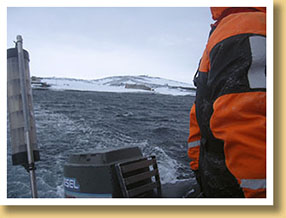 The wind picked up to 35 knots with gusts to 50 knots so the wind chill factor took the effective temperature down to between -13 to -22 degrees.
The wind picked up to 35 knots with gusts to 50 knots so the wind chill factor took the effective temperature down to between -13 to -22 degrees.
Around us, the sky has been overcast, but the sun does get through in the distance so we have views of mountains two both sides of us and in front of us, with the tops cut off. Pictures unfortunately barely capture the beauty of the site. There are occasionally icebergs, some deep blue around us. When the clouds lift enough to see the top of the mountains, they appear to be smothered in low fog, which is actually glaciers surrounding them on all sides and going right down to the water. In some cases, the coast to which we are moving is simply a wall of ice several stories high. Now and then, we pass close to icebergs that are true things of beauty.
Today we prepare for going ashore to see Captain Robert Falcon Scott's hut from his expedition on the Terra-Nova to the Ross ice shelf (1910-1912). Captain Scott was an officer of the Royal Navy who was meticulous, authoritarian and strict. He was to carry out oceanographic, geological and biological research in lands that had never before been explored. He was a part of the British National Antarctic expedition and succeeded where Ernest Shackleton failed. He was the first Englishman to get to the South Pole and the second person after Roald Amundsen. 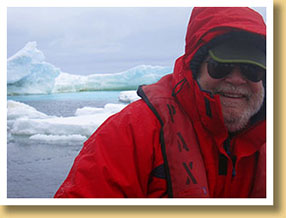 However, on the way back, he and his four companions froze to death. This was in March of 1912. Also in 1910, the Norwegians under Amundsen came with dogs, sleds and specialists who could help make the trip a success. They had a very well organized plan that included rest days, and using foods that contained enough vitamin C to stop scurvy. The British essentially manned their expeditions with well connected "gentlemen" who had no particular skills. They did not have solid planning. Their diet was wrong and they got sick. They tried to use horses not sled dogs because they were "British not Norwegian." It is likely why their voyages were "heroic" but often tragic. Roald Amundsen reached the South Pole on December 14, 1911.
However, on the way back, he and his four companions froze to death. This was in March of 1912. Also in 1910, the Norwegians under Amundsen came with dogs, sleds and specialists who could help make the trip a success. They had a very well organized plan that included rest days, and using foods that contained enough vitamin C to stop scurvy. The British essentially manned their expeditions with well connected "gentlemen" who had no particular skills. They did not have solid planning. Their diet was wrong and they got sick. They tried to use horses not sled dogs because they were "British not Norwegian." It is likely why their voyages were "heroic" but often tragic. Roald Amundsen reached the South Pole on December 14, 1911.
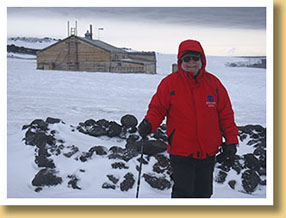 I put on five layers of clothing, nearly every warm and/or waterproof thing I brought. That included mittens over gloves, triple head coverings (hat, an underarmor hood, and my jacket hood), three pairs of underarmor pants, plus my track suit bottoms and my outer water proof coverings. For tops I had a sweater, two levels of underarmor coverings plus a third water repellent shirt and my heavy coat. My feet were covered by silk stockings, wool stockings and my waterproof boots. Getting into the zodiac was easier than last time, both because I had done it before and because the sea was not surging as much despite the wind. The trip to shore was wild and windy, but only a little bit wet.
I put on five layers of clothing, nearly every warm and/or waterproof thing I brought. That included mittens over gloves, triple head coverings (hat, an underarmor hood, and my jacket hood), three pairs of underarmor pants, plus my track suit bottoms and my outer water proof coverings. For tops I had a sweater, two levels of underarmor coverings plus a third water repellent shirt and my heavy coat. My feet were covered by silk stockings, wool stockings and my waterproof boots. Getting into the zodiac was easier than last time, both because I had done it before and because the sea was not surging as much despite the wind. The trip to shore was wild and windy, but only a little bit wet. 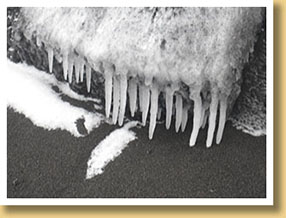 On shore, we encounter one lonely penguin whom I took a video of as he waddled in front of me.We were divided into groups to visit Scott's hut and mine was the last one,so I had about 1 1/2 hours to brave the wind and look at Antarctica. Here, it is volcanic so the soil is jet black and essentially made up of sand dune like volcanic rocks. They are covered by snow in places, ice in others and bare in some. The wind was vicious when you faced it or stood in the open. It managed to penetrate my clothing in places, particularly up under my coat from the back, working its way through the layers of clothing covering my lower spine. That said, it was not uncomfortable, just noticeable. On
On shore, we encounter one lonely penguin whom I took a video of as he waddled in front of me.We were divided into groups to visit Scott's hut and mine was the last one,so I had about 1 1/2 hours to brave the wind and look at Antarctica. Here, it is volcanic so the soil is jet black and essentially made up of sand dune like volcanic rocks. They are covered by snow in places, ice in others and bare in some. The wind was vicious when you faced it or stood in the open. It managed to penetrate my clothing in places, particularly up under my coat from the back, working its way through the layers of clothing covering my lower spine. That said, it was not uncomfortable, just noticeable. On 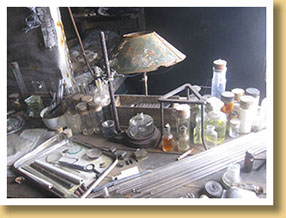 occasion, my hands stung from the cold usually when I went down to just using gloves to take pictures. I hiked up some hills, watched my penguin for quite a while. I disturbed a nest of Skuas, the bird that hunts penguins, their young and their eggs. They soared above us, stopped almost stationary over us because of the wind. I found a large rock to hide behind for a while to get out of the wind. Later, I crossed a small ice field. While it is bitterly cold here, it is also starkly beautiful, particularly when you look out at the ice bound mountains ringing the area.
occasion, my hands stung from the cold usually when I went down to just using gloves to take pictures. I hiked up some hills, watched my penguin for quite a while. I disturbed a nest of Skuas, the bird that hunts penguins, their young and their eggs. They soared above us, stopped almost stationary over us because of the wind. I found a large rock to hide behind for a while to get out of the wind. Later, I crossed a small ice field. While it is bitterly cold here, it is also starkly beautiful, particularly when you look out at the ice bound mountains ringing the area.
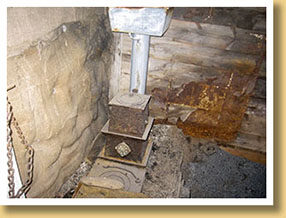 Eventually, it was my turn to go visit the hut. Only 12 people are permitted inside at a time and we cannot touch it and must have are feet cleaned before entering. It was well laid out with one side devoted to the storage of tools and food. The food included penguin eggs, whale blubber, seals, penguins and canned items from
Eventually, it was my turn to go visit the hut. Only 12 people are permitted inside at a time and we cannot touch it and must have are feet cleaned before entering. It was well laid out with one side devoted to the storage of tools and food. The food included penguin eggs, whale blubber, seals, penguins and canned items from 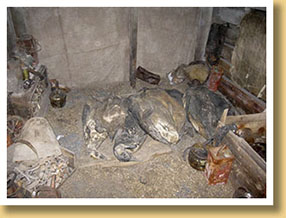 Britain. The other side was the living quarters with a kitchen full of canned foods, bunks, pictures of loved ones on the walls,tables with equipment for the photographer and physicists, plus Scott's quarters including his bunk, table and chairs. On the hill above the hut is a cross commemorating the explorers killed here, including Scott."
Britain. The other side was the living quarters with a kitchen full of canned foods, bunks, pictures of loved ones on the walls,tables with equipment for the photographer and physicists, plus Scott's quarters including his bunk, table and chairs. On the hill above the hut is a cross commemorating the explorers killed here, including Scott."